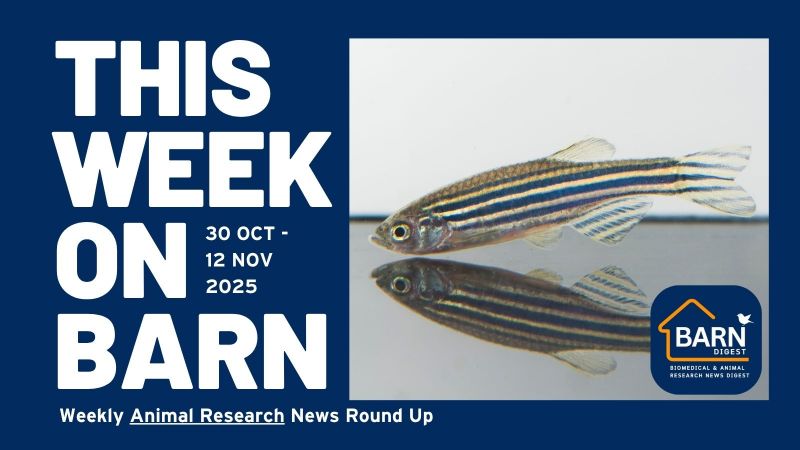
 The Biomedical Animal Research News (BARN) Digest collates animal research news from UAR’s 150+ member organisations into one, easy to access, feed. These animal research related stories include topics such as: medical studies and advancements; animal welfare and 3Rs news; funding, regulatory, and policy news; and conservation and environmental research that involves animal testing.
The Biomedical Animal Research News (BARN) Digest collates animal research news from UAR’s 150+ member organisations into one, easy to access, feed. These animal research related stories include topics such as: medical studies and advancements; animal welfare and 3Rs news; funding, regulatory, and policy news; and conservation and environmental research that involves animal testing.
Each week, we pick the most interesting, groundbreaking, and important news to feature in a weekly news roundup. In this round up we feature news stories from 8 - 14 May 2025.
View BARN to see daily news updates from UAR members.
BASIC RESEARCH
Scientists film the heart forming in 3D earlier than ever before
UCL, FRANCIS CRICK INSTITUTE | MICE
"Researchers at UCL and the Francis Crick Institute have, for the first time, identified the origin of cardiac cells using 3D images of a heart forming in real-time, inside a living mouse embryo. For the study, published in The EMBO Journal, the team used a technique called advanced light-sheet microscopy on a specially engineered mouse model. This is a method where a thin sheet of light is used to illuminate and take detailed pictures of tiny samples, creating clear 3D images without causing any damage to living tissue."
https://www.ucl.ac.uk/news/2025/may/scientists-film-heart-forming-3d-earlier-ever
Dual biological clocks discovered in intertidal crustaceans
MRC LABORATORY OF MOLECULAR BIOLOGY | CRUSTACEANS
"The crustaceans were kept in different conditions to simulate different environmental cycles; light-dark cycles, constant darkness, and mechanical tides simulated by shaking. The activity of both species was closely monitored to determine if they were exhibiting circadian (~24 hour) or circatidal (~12.4 hour) rhythms. To identify the clock cells of interest, the group used brain imaging and gene expression mapping techniques to visualise where and when the specific genes were active in brain tissue."
https://www2.mrc-lmb.cam.ac.uk/dual-biological-clocks-discovered-in-intertidal-crustaceans/
DRUG DEVELOPMENT
Researchers move a step closer to improving immunotherapy treatment for melanoma patients
KINGS COLLEGE LONDON | MICE
"Curestarter funding has allowed Dr Hurlstone and his team to investigate in detail how this treatment combination can target melanoma cells, by studying mice with melanoma, and also melanoma cells grown in the lab.
Excitingly, the team saw that this treatment combination was very effective in helping our immune system become primed for targeting cancer cells."
New research finds Motor Neuron Disease drug safe and effective at low doses
KINGS COLLEGE LONDON | TREATMENT RELIED ON ANIMAL RESEARCH
"The crustaceans were kept in different conditions to simulate different environmental cycles; light-dark cycles, constant darkness, and mechanical tides simulated by shaking. The activity of both species was closely monitored to determine if they were exhibiting circadian (~24 hour) or circatidal (~12.4 hour) rhythms. To identify the clock cells of interest, the group used brain imaging and gene expression mapping techniques to visualise where and when the specific genes were active in brain tissue."
https://www2.mrc-lmb.cam.ac.uk/dual-biological-clocks-discovered-in-intertidal-crustaceans/
Ask a Scientist: Humanized Mice vs. Conventional Mice
CHARLES RIVER EUREKA BLOG | DRUG DEVELOPMENT
"Mice have long served as a preferred species for biomedical research in the preclinical realm due to their anatomical, physiological, and genetic similarity to humans. Take cancer research for example. In the nearly 50 years since the original models of cancer emerged, mouse models have contributed to nearly every corner of cancer research, and these models have evolved well beyond simple transgenic or syngeneic models to a wider range of complex models, including CDX (cell line derived xenograft) and PDX (patient derived xenograft) mouse models and humanized mouse models."
https://www.criver.com/eureka/ask-scientist-humanized-mice-vs-conventional-mice
NON-ANIMAL RESEARCH ADVANCEMENTS (NAMS AND NATS)
New 3D 'gut-on-a-chip' miniature model set to help cancer patients
WORLDWIDE CANCER RESEARCH | NAMS & NATS
"Dr Luigi Nezi and his team in Italy have developed a new way to study how bacteria in our gut can influence cancer treatments. The new 3D ‘gut-on-a-chip’ is a miniature model of our own intestines, even moving as ours do while digesting food. Importantly, the model can also be ‘seeded’ with bacteria from patient samples. This means it can potentially be used to spot patients who are less likely to respond to immunotherapy, and find ways to help them."
The mysterious stem cells that could hold the key to beating bowel cancer
CANCER RESEARCH UK | NAMS & NATS
"Dr Luigi Nezi and his team in Italy have developed a new way to study how bacteria in our gut can influence cancer treatments. The new 3D ‘gut-on-a-chip’ is a miniature model of our own intestines, even moving as ours do while digesting food. Importantly, the model can also be ‘seeded’ with bacteria from patient samples. This means it can potentially be used to spot patients who are less likely to respond to immunotherapy, and find ways to help them. "
ANIMAL BEHAVIOUR
New study reveals that sweetness is not a bumblebee's only weakness
UNIVERSITY OF SUSSEX | BUMBLEBEES
"A new breakthrough study by the University of Sussex has revealed for the first time that bumblebees pick the flowers they choose to pollinate based on a variety of factors, and not just the sweetness.
The new research shows that bumblebees can taste protein - specifically the amino acid valine - in nectar and pollen, indicating their flower choices are driven by nutritional value, taste and flavour, and not just sweetness."
https://www.sussex.ac.uk/broadcast/read/68087#
Visit BARN for daily news updates
Last edited: 20 October 2025 13:22



